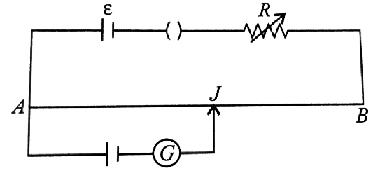Test: Potentiometer (NCERT) - NEET MCQ
5 Questions MCQ Test - Test: Potentiometer (NCERT)
In a potentiometer of 10 wires, the balance point is obtained on the 7th wire. To shift the balance point to 9th wire, we should
AB is a wire of potentiometer with the increase in the value of resistance R, the shift in the balance point J will be


In a potentiometer a cell of emf 1.5 V gives a balanced point at 32 cm length of the wire. If the cell is replaced by another cell then the balance point shifts to 65.0 cm then the emf of second cell is
3V poteniometer used for the determination of internal resistance of a 2.4V cell. The balanced point of the cell in open circuit is 75.8cm. When a resistor of 10.2Ω is used in the external circuit of the cell the balance point shifts to 68.3cm length of the potentiometer wire. The internal resistance of the cell is
In a potentiometer the balancing with a cell is at length of 220cm. On shunting the cell with a resistance of 3Ω balance length becomes 130cm. What is the internal resistance of this cell?

















